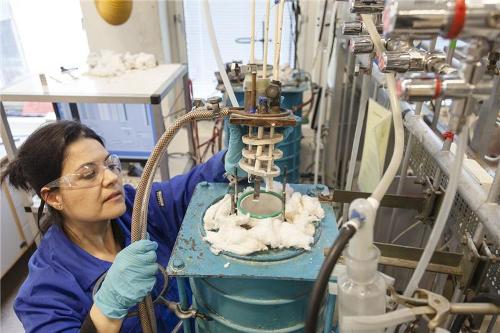Rare earth metals (REM) used in energy-conservation efforts is expected to become scarce by 2015. Dysprosium and neodymium, which are REMs, are considered as “key enablers” of green technologies. Scientists in Norway are attempting to extract REMs from scrap.

The recovery product: The content of an opened crucible after the alloy raw material has been subjected to electrolysis. Ana María Martínez hopes that the silver-grey material in the bottom of the crucible can become an alloy that can be used to make new magnets.Photo: Thor Nielsen.
Electric and hybrid cars, and wind turbines use rare earth metals and the demand for these metals has been exceeding supply. These elements are also being used in computers, LED lamps and mobile telephones. Identifying and commencing operations of new mines take up a lot of time. Hence, recovery of these materials is necessary to sustain development of environmentally friendly cars and wind-turbines.
China which had been producing 95% of the REMs has restricted exports over the past couple of years. This has further raised the importance of REM recovery, which is termed as “urban mining”. Materials scientists from SINTEF have conducted research on permanent magnets, which contain high volume and value of REMs. Most of these magnets contain iron, boron, neodymium, praseodymium and dysprosium.
Initial studies performed by Ana María Martínez, a researcher at SINTEF Materials and Chemistry, have led to the belief that a version of the electrolytic technology that is being used in aluminum smelters may be used for recovering magnetic alloys in scrap and discarded magnets. While laboratory-scale electrolysis has shown the feasibility of such a process, further development has to be done to optimize it.
Several challenges exist in the pre-electrolytic stage. Magnets have to be collected, dismantled and demagnetized. The scientists surmise that utilizing scrap from magnet manufacturers will be a viable option for initiating research as they are non-magnetic.
Many hybrid vehicles utilize batteries that contain rare earth elements such as cerium, neodymium, praseodymium and lanthanum. SINTEF scientists are studying ways of utilizing high-temperature metallurgical methods to recover REMs from Nickel metal hydride batteries.
Disclaimer: The views expressed here are those of the author expressed in their private capacity and do not necessarily represent the views of AZoM.com Limited T/A AZoNetwork the owner and operator of this website. This disclaimer forms part of the Terms and conditions of use of this website.